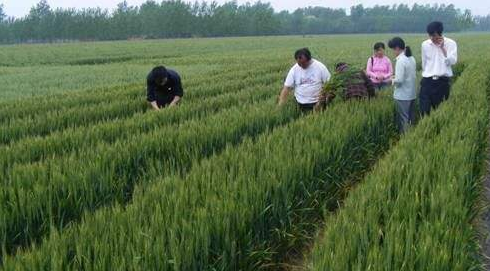The planting of spring wheat in saline-alkali soil is carried out by conventional planting methods. Salinization of saline-alkaline soil is serious, wheat seedling rate is low, soil fertility is low, and phosphorus and nitrogen are generally deficient. After rainfall, salt is often caused, causing dead seedlings or inhibiting seedling growth. Therefore, high-yield and salt-tolerant wheat varieties should be used in such areas, and measures such as leveling the land, washing the salt, renovating the fields, and fertilizing the soil should be adopted. First, improve the soil 1. Wash the salt on the ground It is required that the land must be leveled, the field is less than 13.3 hectares, the drainage system is perfect, and the groundwater level must be reduced to less than 1.5 meters. After the summer harvest crops have to be ploughed and sun-dried, the high-temperature summer irrigation water can effectively improve the desalination effect. . In order to prevent the return of salt from the backing of the slab, it is necessary to re-cultivate one time, and the winter irrigation should be kept in spring; the irrigation quota should be strictly controlled to avoid excessive watering and raise the water table. 2. Apply enough organic fertilizer Organic fertilizers include human excrement, poultry manure, manure, compost, green manure and soil fertilizer, which have the characteristics of wide source, full fat, low price, etc., and are not easy to lose, and have long fertilizer efficiency, that is, fertilizer can be used, and soil can be changed. . At present, it is better to apply organic fertilizer as the base fertilizer before the land preparation in autumn. 3. Leveling the land Deep ploughing and small hoe cultivation are the basis for water-saving irrigation and improved irrigation quality. Small hoes are best sown in 60 cm, 90 cm and 120 cm. The flat wheat field adopts shallow wide fur channels and short spacing of the furrows, which is beneficial to improve the quality of irrigation, increase the number of harvested wheat fields and increase the yield. 4. Multiple cropping green manure After harvesting of winter and spring wheat in various places, generally in July and mid-July, there is still an accumulated temperature of ≥5 °C in northern Xinjiang of 1500-2000 °C. The green manure will have a growth period of 80 to 90 days at the end of September or early October, and will be rolled up in early October to create good fertility conditions for the next spring. As a green manure crop, in addition to oil sunflower, rapeseed, grass rafts, etc. can be. 5. Straw returning It can increase soil organic matter and fertilize soil fertility. Second, the variety selection The current spring wheat in Xinjiang is a high-yield, high-yield product that is not salt-tolerant and is not suitable for planting in plots with high salt concentrations. Among them, fresh springs 6, 7, 8, 11, and 12 can be moderately and below. The plot is planted. Some salt-tolerant lines such as temperature 4, 91-4-2, 92-8-2 have been cultivated. Third, the field management measures Early broadcast Xinjiang Spring Festival Evening, the temperature rises rapidly after the spring, and the saline-alkali soil loses quickly, and it is too late to prepare in the spring. Therefore, in the first year, the ground is required to be in a state to be broadcast, and the seeds are processed before sowing. Spring wheat sowing should be as early as possible. In principle, the machine can be planted in the field for planting, and should be properly planted at the time of sowing to improve the quality of sowing. 2. Reasonable irrigation In order to avoid drought, proper light irrigation and digestive irrigation should be carried out in the first stage, that is, in the 2~3 leaf stage, the second water should be followed closely, and should not exceed 15 days, so as to avoid the surface knot, root injury, or salt return. Yellow seedlings occur. Do not over-fill the water in the middle and late stages to avoid damage and raise the water table. In addition, if there is weather and soil drought during emergence, one or two waters should be added to ensure the emergence of seedlings in the field. 3. Rational use of fertilizer Because the spring wheat in saline-alkali land is easy to be de-fertilized, compared with the conventional spring wheat planting, the application of base fertilizer, seed fertilizer and topdressing, the spring wheat in saline-alkali soil should increase the proportion and frequency of nitrogen fertilizer application, with less application and more chasing. In order to ensure the need of grouting, foliar fertilizer can be sprayed appropriately, and potassium dihydrogen phosphate plus urea and trace elements are often used. 4. Eliminate weeds in the field The time of elimination is generally in the 3 to 5 leaf stage of wheat, and it should not be too early or too late. 5. Defense against hot air In addition to salt-tolerant, drought-tolerant varieties, fertilization and soil improvement measures, irrigation can also be adopted. According to the weather conditions in the later period, irrigation should be carried out before the onset of dry hot air to improve the humidity in the field. In addition, foliar application of FA dryland dragon, potassium dihydrogen phosphate + urea and calcium chloride suffocating measures can effectively prevent dry hot air. 6. Harvest Artificial harvesting should be carried out in the wheat wax maturity stage, which can effectively prevent the grain from falling off; the machine harvesting can be carried out after the wheat yellow is ripe and the kernels are hardened and the stems are dry. Late harvesting can reverse the nutrients of wheat grain, resulting in low yields. Youth Biotech CO,. Ltd. , https://www.youtherb.com